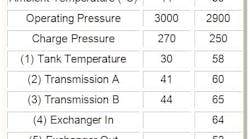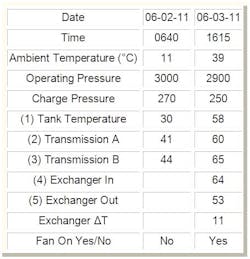A recent client had a series of catastrophic pump failures. These hydraulic pumps were achieving less than half their expected service life. So naturally, my client wanted some answers. At our first meeting the client opened proceedings with a brief history on the machine, an account of the events leading up to the failures and then pushed a stack of oil analysis reports across the table.
After I finished taking notes on what I'd just been told, I fired off my first question:
"What is the hydraulic system's normal operating temperature?"
Stunned silence. Client shrugs his shoulders.
"O-K … what's the system's usual operating pressure range?"
Blank look from client … "Err… dunno … we don't monitor either of those things."
At the end of the meeting we took a walk through to the control room. Both operating pressure and temperature were displayed on the default PLC screen - albeit along with a lot of obviously more important production information. Say no more.
But could YOU answer these two basic questions about the "vital signs" of the hydraulic equipment you maintain, repair or operate? If not, I strongly recommend you make the effort to get to know your hydraulic equipment better.
This information is easy to collect, can give valuable insight to the health of the machine and is essential data if failure analysis is required. Here's how I recommend you do it:
First you need an infrared thermometer, also called a heat gun. If you don't have, you'll need to invest around $100 to get one and then familiarize yourself on how to use it. Next, using a permanent marker or paint stick, draw a small target on the hydraulic tank below minimum oil level and away from the cooler return. Label it "1". This marks the spot where you'll take your tank oil-temperature readings.
By the way, the idea behind these 'targets' is that regardless of who takes the temperature readings they'll be taken from the same place each time.
If the system is a closed-circuit hydrostatic transmission, mark a convenient location on each leg of the transmission loop and number them "2" and "3". Skip this step for open-circuit hydraulic systems.
Next, mark a target on the heat exchanger inlet and outlet and number them "4" and "5" respectively. This records the temperature drop across the exchanger. The benefit of doing this is, if the oil flow-rate through the exchanger and the temperature drop across it are known, the heat rejection of the exchanger can be calculated. See pages 103-104 of The Hydraulic Troubleshooting Handbook for detailed instructions.
And if the system IS overheating, knowing the actual heat rejection of the exchanger can help determine whether the problem is the result of an increase in heat load - due to an increase in internal leakage, for example, or whether the problem lies in the cooling circuit itself.
Next, if not already available, install a pressure gauge or transducer to record operating pressure, and if the system is a closed-circuit hydrostatic transmission, install a similar device to record charge pressure.
With that done, now draw up a table like the one shown below to record the date, time, ambient air temperature, operating oil temperatures and operating pressure(s). Note that there is little point in recording the temperature drop across the heat exchanger if the fan or water pump isn't running. And charge pressure is only relevant to closed-circuit hydrostatic transmissions.
Recording a hydraulic machine's vital signs
In terms of compiling this data, it's a good idea to take readings on the hottest and coldest days of the year and on a couple of average temperature days in between. This provides a baseline of information. Beyond that, taking readings at regular intervals - each day or shift for example, can provide early warning of impending problems. And if the system starts to give trouble, taking a set of readings will reveal if it's operating outside its 'normal' parameters.
Bottom line: allowing a hydraulic machine to run hot is a costly mistake, and one that a lot of hydraulic equipment users make. There are six more to avoid, which I explain in "6 Costly Mistakes Most Hydraulics Users Make…" If you haven't read it yet, download your free copy here.


